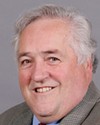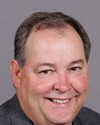I would be pleased to.
My name is Rick Burton. I'm the vice-president of HR modernization at the Canada Public Service Agency.
The purpose of my presentation is to describe the public service-wide compensation capacity-building work and results in the compensation community.
I will describe the context and the capacity-building methodology.
A few words on community demographics and
priorities and progress to date.
Finally, I have a short comment on classification of compensation advisors.
Compensation advisors have to be seen in the context of a broader effort that we're undertaking to rebuild the capacity in the human resource community. Compensation advisors we see as part of that community of interest, and we're taking care to make sure they're included in our efforts.
Overall our goal is to develop a healthy, sustainable human resources management committee so that we're delivering relevant quality service based on evolving roles in human resource management, which, as you probably all know, are changing dramatically.
Our key focus in the initial efforts was on the HR specialists themselves, because that's where we actually saw a real challenge that we needed to fix in terms of capacity. Our second focus of the initiative is to focus on compensation advisors, and that work began in earnest in March of this year. I'll have some more to say about that.
The next slide, slide 5, makes the point--I hope it makes the point--that we've taken a very rigorous approach to making sure that we know the nature of the capacity issue. Quite often you hear dramatic stories, but when you dig into them, they don't turn out to be the reality; in some cases they are. We want to be sure that we take a very rigorous approach.
You can see the lists of things we've done here; I won't cover them all in detail. We've surveyed the heads of HRs, those people in departments that Hélène referred to, who actually are the focal point for HR management. We've had an interdepartmental working group with our central agency, going to look at the whole issue of compensation community. We've done a number of focus groups, particularly in the regions, because we wanted to be sure we were getting the regional input and not just hearing from headquarters in various departments.
The most important step in this is that in August and September we conducted demographic analyses of the current and future needs of the compensation community, and we've consulted best practices literature to find out what's going on in the private sector, and so on, that we can bring to bear on the community in the public service.
We've presented our plan to a committee of deputy ministers. I want to make the point here that this is a public service-wide initiative, and deputies are very concerned about the health of this community and the HR community generally. We wanted to be sure they endorsed the approach we were taking. The plan we've developed is in an annex in your report; I think I missed one annex in my earlier comments.
I've attached three annexes. The first one talks about the general approach we're taking to rebuild the HR capacity, and I can take you through that later, if we want to, in question period. The second one talks about our approach for the compensation community. The third one, when I get to it, will refer to the work we're doing for the professional development of the community, which of course includes compensation.
Finally, we've consulted over 650 compensation professionals across the public service, and we continue to do that.
The next slide covers some of the demographics of the community. I'll just go through it very briefly. As Hélène said, there are roughly 2,100 employees in the compensation community. The community, on average, is 45 years old, which is only a year and a half older than the average of the whole core public administration that Hélène referred to, and 55% of those 2,100 employees in the community are actually at the AS-02 working level, the compensation advisors who we generally refer to now when we're talking to you. The average salary in the community is $51,700.
We're making good progress in terms of the makeup of the community in terms of representation in the areas of people with disabilities and aboriginal people. However, we're not doing so well on the visible minority representation, which, as you can see, is slightly lower than the workforce availability for visible minorities. The good news is that we're over our target in our recent recruitment campaign in terms of attracting visible minorities, so that is a good news story.
Perhaps the key issue, in terms of some of the earlier discussions that have gone on, is that the attrition rate projected over the next two years is 10%. If we compare that to two years for which we actually have records in the overall core public administration, it's 10.5%, so it's not, in our view, a crisis, but it's definitely something that needs to be managed, and that's why we've taken this public service-wide view to it.
I should say too that training is an issue—and I'll touch on it in a minute—but it does take a considerable amount of time to train compensation advisers, anywhere from one to two years. We've done a lot of work to put new systems in place that ease their work, but Hélène can tell you that when you add up all the collective agreements and all the overtime definitions, there are about 71,000 payrolls that these folks have to deal with.
Then, finally, there are 258 vacancies across the community. Again, that represents the whole 2,100, so when you break it down to the 1,500 or so who are actually the compensation advisers at the working level, it's not that many.
Priorities for action are as follows: attract and retain qualified candidates to ensure community health and renewal; provide common training and career development; and formalize the transfer and acquisition of knowledge, expertise and skills.
Progress to date on the community. I think when our president, Nicole Jauvin, was here back in April, she mentioned that we were about to engage in a fairly massive recruitment campaign, so I'd like to just give you an update on where we are at this point.
Our first annual recruiting drive is under way. We received 5,800 applications from across Canada, including people inside the public service. We ensured a commitment to build a representative workforce, and as I referred to earlier, we are now able to meet our visible minority targets in those areas.
We've come out, through a very structured assessment process, with 128 qualified candidates, with strong representation, as I said, from the visible minorities: 29%. That breaks out about almost half and half: 58 who are external to the public service and 70 who are internal. So while there has been a concern I think expressed with people moving out of this group, there's a certain healthy vitality of people who want to move into this area. So I think it's good, from a career progression point of view.
Departments have committed to hiring 113 of these candidates, and this we're planning to do every year for the next four to five years until we really build up the capacity. Some of the issues here revolve around how many candidates can a department absorb and train and manage in a year. It still leaves us a few extra, where, if the department has a pressing need, we now have people in a mini-pool who can actually be picked up fairly easily.
We have developed a professional development framework, as I said earlier. The third annex in your package does lay out that framework, and you'll see that we have quite a learning program for the HR community, as a whole, including compensation advisors and including a program for certification.
Curriculum development certification training is under development. I want to say as well that there has been excellent support in the community, across departments and agencies, in this effort, and I want to acknowledge the work that the Public Service Alliance have done with us, who represent these advisors. They've participated in these discussions and held their own. And many of the things that we're hearing are common, and it gives us some comfort that we're tackling the right issues. The next recruitment drive is scheduled for September of this year, so we'll continue the process.
Finally, I would like to just say a word about classification if I could. Classification is about internal relativity, as Hélène said: how do we measure the relativity of work within the public service? Not the work outside, but inside the public service. It's about group and level, so are you a member of this group or that group, and then within that group where do you come in the pecking order?
In the evolution of the work assigned for compensation and benefits advisor, they've been reclassified, as you can see on slide 9, three times, from a CR-04 to a CR-05 in 1989, from a CR-05 to an AS-01 in 1997, and from an AS-01 to an AS-02 in the year 2000. Some of this is meant to track and reflect the evolution of work and the complexity of work. Collective agreements are more complex now; there are more complex transactions. These compensation advisors do play an advisory or an analytical role. I want to make the point, though, that they are not financial advisors, so there's a limit to where they can go in terms of providing advice to employees.
There has been no significant change to the work since 2000. There was a classification grievance, resolved in 2003, which confirmed the classification at the AS-02 level. This was an interdepartmental grievance committee that looked at the work right across the public service and confirmed that it was at the 02 level.
In our system, classification decisions are final and binding unless it can be shown there has been a significant change in the work, and, as I said, there hasn't been since 2000.
I don't want to get into the details of where we're going more broadly in classification or form, unless you ask me, but we are looking at this group of people who are members of the AS community, who themselves are part of a broader group, the PA community.
If I could take you to the other handout that I hope you have with you, I'll just take you to one point there, just so you see where the compensation advisors fit into the whole job structure of the public service.
Every job in the public service you can find on this page, and the colour code reflects union representation. You can see the numbers in each group and so on. So I'll take you to the very top left-hand corner. In the yellow you will see a group called the program and administrative services, or the PA group, as we refer to it. It comprises many former groups in the public service, including the administrative services group, which is the AS group.
The compensation advisors are within that AS group; they're not exclusively the group, but they're members of that group. So you can see where it fits in the broader context of classification.
Our reform efforts are towards modernizing the standards, one by one, and describing the work in each of these groups, and we're making fairly good progress in doing that. We intend to look at the PA group, because you can see that it's 89,000 strong, which is almost half of the core public administration that Hélène referred to.
That's the end of my formal brief. If at some point you want to go through the three attachments I provided, I'd be happy to.



